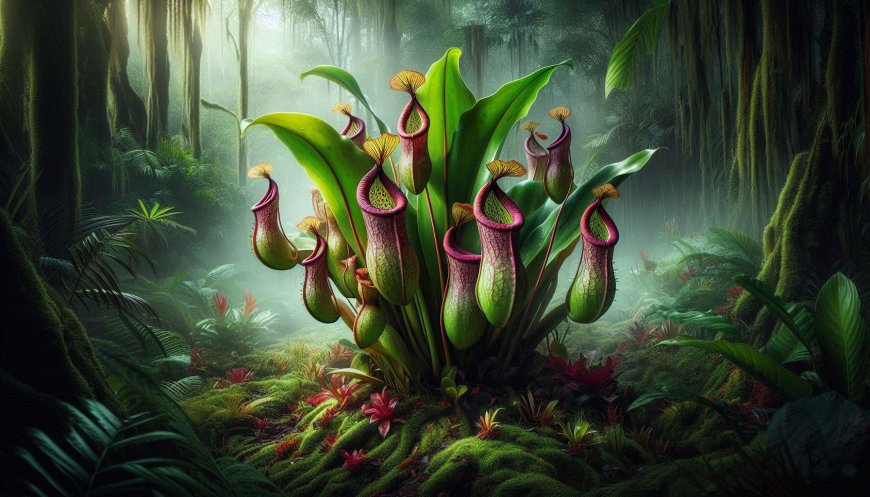Nepenthes – Nature’s Enigmatic Carnivorous Plants
Explore the fascinating world of Nepenthes, the carnivorous tropical pitcher plants. Learn about their unique feeding mechanisms, stunning adaptations, and the ecosystems they thrive in. From trapping insects to symbiotic relationships, discover how these plants survive in nutrient-poor soils.

Nepenthes, commonly known as tropical pitcher plants, are among the most fascinating organisms in the plant kingdom. Unlike typical plants that derive nutrients solely from soil, Nepenthes have evolved a unique way of supplementing their diet—by trapping and digesting insects and small animals. These carnivorous plants, found primarily in Southeast Asia, particularly in Borneo, Sumatra, and the Philippines, captivate botanists and plant enthusiasts alike with their unusual adaptations and stunningly complex pitcher structures.
Anatomy of a Nepenthes
At first glance, a Nepenthes plant might look like something out of a science fiction movie. Its leaves morph into tubular, lidded pitchers filled with digestive fluids, ready to ensnare unsuspecting prey. The pitchers vary in size and color, from deep reds and purples to light greens speckled with dark spots, with some reaching over a foot in length. The shape and slick inner surfaces of the pitchers make escape almost impossible for any unfortunate insect that tumbles inside.
The plant’s structure is incredibly specialized: the lid above each pitcher prevents rainwater from diluting its digestive juices, while a nectar-rich rim, or peristome, attracts insects and other small creatures. Once the prey is lured close enough, it slips on the slick edge, falling into the acidic digestive pool below, where enzymes break down the nutrients.
A Nutritional Advantage in Poor Soils
One of the primary reasons Nepenthes evolved to become carnivorous is the nutrient-poor soils in their native habitats, often lacking in nitrogen and phosphorus—essential elements for plant growth. By consuming insects, the plant gains a significant advantage, deriving nutrients directly from its prey to supplement what it can absorb from the soil. This adaptation allows Nepenthes to thrive in environments that would otherwise be inhospitable.
A Fascinating Range of Prey
While insects are the most common catch, some larger Nepenthes species have developed pitchers that can trap small animals, such as frogs, lizards, and even small mammals like rats. These larger plants, such as Nepenthes rajah and Nepenthes attenboroughii, have evolved particularly robust pitchers to handle bigger prey, allowing them to obtain more nutrients than smaller species can.
Symbiotic Relationships with Wildlife
Despite their deadly reputation, Nepenthes have developed surprisingly symbiotic relationships with certain animal species. For example, the tree shrew in Borneo has a mutually beneficial relationship with certain Nepenthes species. In a unique arrangement, the plant produces nectar around the rim of the pitcher, which attracts the shrew. While feeding, the shrew perches on the pitcher’s edge and defecates into it, providing the plant with additional nutrients in the form of nitrogen-rich waste.
Similarly, mosquito larvae and certain species of ants inhabit the pitchers of Nepenthes, benefiting from the nutrient-rich environment without falling prey to the plant. This complex interplay between predator and mutualistic partner showcases the remarkable adaptability of these plants within their ecosystems.
Nepenthes and Conservation
Nepenthes have become popular among plant collectors worldwide due to their exotic appearance and unique feeding habits. However, habitat loss and over-collection have endangered many species, prompting conservation efforts in several countries. Botanical gardens, nurseries, and conservation groups work tirelessly to protect and propagate these plants, ensuring they continue to thrive in the wild.
Cultivating Nepenthes: A Delicate Art
Cultivating Nepenthes can be rewarding yet challenging, as these plants require specific humidity, temperature, and light conditions to thrive. Mimicking their native tropical environment is essential, making them popular among experienced gardeners and hobbyists who enjoy the challenge of caring for these living marvels. For those who are successful, the reward is a captivating plant that offers a window into the ingenuity of nature.
Final Thoughts
Nepenthes are far more than just carnivorous plants; they are an example of nature’s creativity and adaptability. By developing their own intricate ways to survive, Nepenthes stand as a reminder of the incredible diversity and resourcefulness of life. Whether admired in their natural habitat or carefully nurtured in a greenhouse, Nepenthes continue to captivate and intrigue with their enchanting beauty and fascinating behaviors, inviting us to explore and marvel at the wonders of biology.
What's Your Reaction?




























